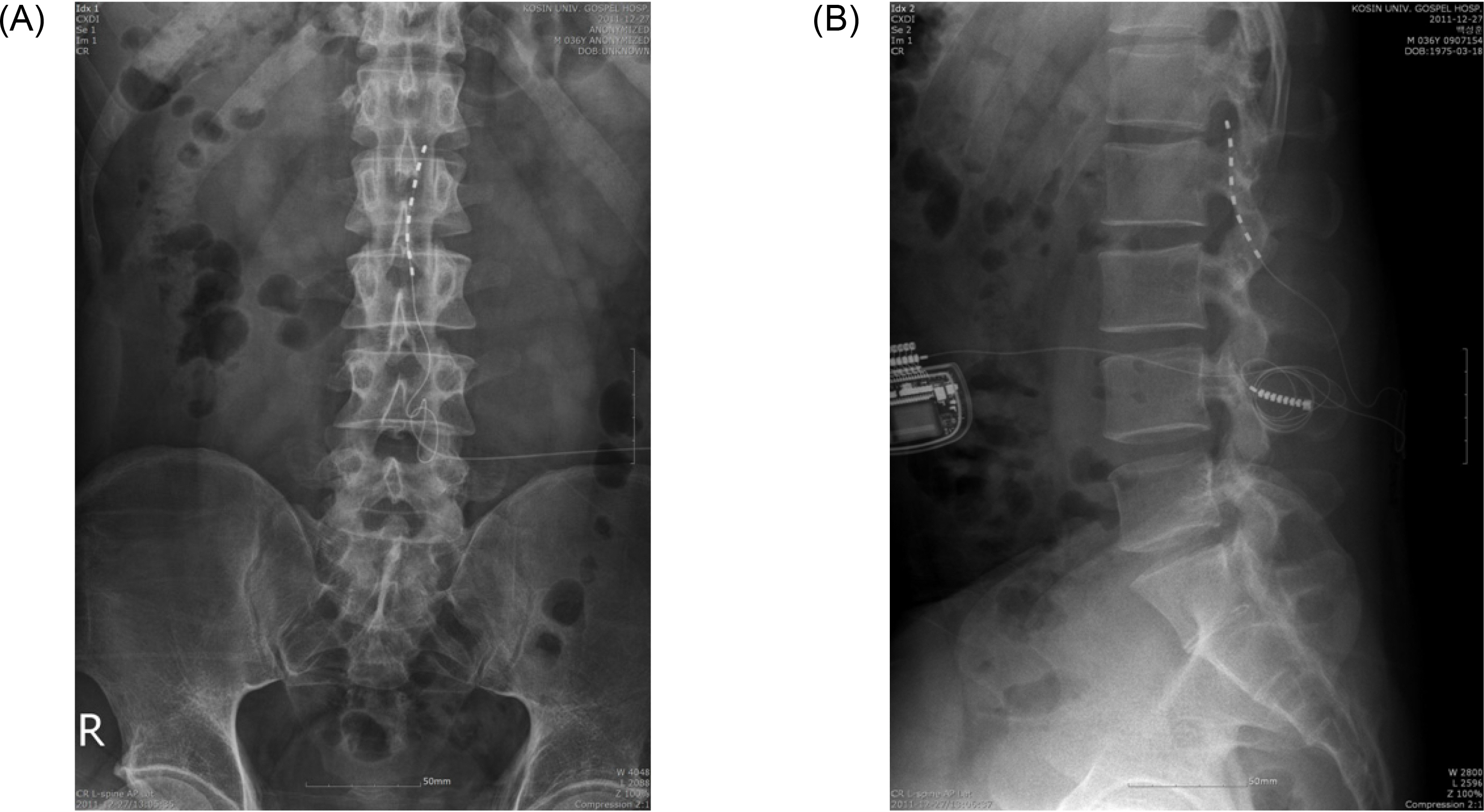Articles
- Page Path
- HOME > Kosin Med J > Volume 29(1); 2014 > Article
-
Case Report
A Case of Lead Migration Caused by Involuntary Movement in Implanted Spinal Cord Stimulation - Ju-Deok Kim, Jeong-Gil Lee, Sang-Su Kim, Hye-Young Shin
-
Kosin Medical Journal 2014;29(1):69-73.
DOI: https://doi.org/10.7180/kmj.2014.29.1.69
Published online: December 17, 2014
Department of Anesthesiology and Pain Medicine, College of Medicine, Kosin University, Busan, Korea
- Corresponding Author: Ju-Deok Kim, Department of Anesthesiology and Pain Medicine, College of Medicine, Kosin University, 34 Amnamdong, Seo-gu, Busan, 602-702, Korea TEL: +82-51-990-6283 FAX: +82-51-254-2504 E-mail: uamyfriends@hanmail.net
• Received: July 1, 2013 • Revised: October 4, 2013 • Accepted: October 16, 2013
Copyright © 2014 Kosin University School of Medicine Proceedings
This is an Open Access article distributed under the terms of the Creative Commons Attribution Non-Commercial License (http://creativecommons.org/licenses/by-nc/3.0/) which permits unrestricted non-commercial use, distribution, and reproduction in any medium, provided the original work is properly cited.
- 838 Views
- 3 Download
Abstract
- Spinal cord stimulation (SCS) is a reliable clinical option for treatment of refractory chronic pain. It is known to be effective method for treating sympathetic pain, failed back surgery syndrome, and complex regional pain syndrome etc. The devices and implantation techniques for SCS are already highly developed and continuously improving, but there are some complications that can not be corrected easily. Lead migration is the most common complication after SCS. It can cause failure of SCS that can make discomfort to patients. Here we describe our experience of lead migration in implanted SCS which was inserted to a patient with complex regional pain syndrome patient.
Fig. 2.The octapolar lead is migrated from 12th thoracic vertebrae to the lower margine of the 1st lumbar vertebrae (A) and 7th, 8th leads are got out of the epidural space (B).


- 1. North RB, Wetzel FT. Spinal cord stimulation for chronic pain of spinal origin: a valuable longterm solution. Spine 2002;27:2584–91.ArticlePubMed
- 2. Mekhail NA, Mathews M, Nageeb F, Guirguis M, Mekhail MN, Cheng J. Retrospective review of 707 cases of spinal cord stimulation: indications and complications. Pain Pract 2011;11:148–53.ArticlePubMed
- 3. North RB, Kidd DH, Zahurak M, James CS, Long DM. Spinal cord stimulation for chronic, intractable pain: experience over two decades. Neurosurgery 1993;32:384–94.PubMed
- 4. Oakley JC, Prager JP. Spinal cord stimulation: mechanisms of action. Spine 2002;27:2574–83.ArticlePubMed
- 5. Yoon JH, Moon DE, Lee CW, Ryu KH. Cervical spinal cord stimulation in a patient with complex regional pain syndrome in the upper extremity. Korean J Pain 2004;17:243–7.Article
- 6. Patel S, Huang DL, Sagher O. Sympathetic mechanisms in cerebral blood flow alterations induced by spinal cord stimulation. J Neurosurg 2003;99:754–61.ArticlePubMed
- 7. Alo KM, Holsheimer J. New trends in neuromodulation for the management of neuropathic pain. Neurosurgery 2002;50:690–703.ArticlePubMed
- 8. Nelson DV, Stacey BR. Interventional therapies in the management of complex regional pain syndrome. Clin J Pain 2006;22:438–42.ArticlePubMed
- 9. Cameron T. Safety and efficacy of spinal cord stimulation for the treatment of chronic pain: A 20-year literature review. J Neurosurg Spine 2004;100:254–67.Article
- 10. McGreevy K, Williams KA, Christo PJ. Cephalad lead migration following spinal cord stimulation implantation. Pain Physician 2012;15:79–87.
- 11. Renard VM, North RB. Prevention of percutaneous electrode migration in spinal cord stimulation by a modification of the standard implantation technique. J Neurosurgery spine 2006;4:300–3.ArticlePubMed
- 12. Mironer YE, Brown C, Satterthwaite JR, Cohen M, Tonder LM, Grumman S. A new technique of "midline anchoring” in spinal cord stimulation dramatically reduces lead migration. Neuromodulation 2004;1:32–7.Article
- 13. Koo MS, Kim YC, Kim MH, Francis SN, Suh JH, Shin WY, et al. Lead breakage in implanted spinal cord stimulation systems. Korean J Anesthesiology 2007;54:229–31.
- 14. Whitworth LA, Feler CA. C1-C2 sublaminar insertion of paddle leads for the management of chronic painful conditions of the upper extremity. Neuromodulation 2003;6:153–7.ArticlePubMed
References
Figure & Data
References
Citations
Citations to this article as recorded by 


 KOSIN UNIVERSITY COLLEGE OF MEDICINE
KOSIN UNIVERSITY COLLEGE OF MEDICINE

 PubReader
PubReader Cite
Cite


